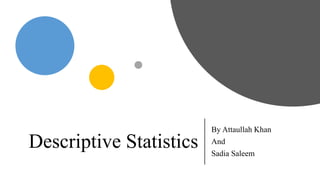Descriptive statistics
•Descargar como PPTX, PDF•
6 recomendaciones•1,145 vistas
What are descriptive Statistics, Types of statistics and its implications. graphs, tables, variation, mean mode median, central tendency,
Denunciar
Compartir
Denunciar
Compartir

Recomendados
Más contenido relacionado
La actualidad más candente
La actualidad más candente (20)
Basics of Educational Statistics (Descriptive statistics)

Basics of Educational Statistics (Descriptive statistics)
Similar a Descriptive statistics
Similar a Descriptive statistics (20)
Practical Research 2 Chapter 3: Common Statistical Tools

Practical Research 2 Chapter 3: Common Statistical Tools
Basic Statistical Concepts in Machine Learning.pptx

Basic Statistical Concepts in Machine Learning.pptx
Exploratory Data Analysis for Biotechnology and Pharmaceutical Sciences

Exploratory Data Analysis for Biotechnology and Pharmaceutical Sciences
Último
This presentation was provided by William Mattingly of the Smithsonian Institution, during the fourth segment of the NISO training series "AI & Prompt Design." Session Four: Structured Data and Assistants, was held on April 25, 2024.Mattingly "AI & Prompt Design: Structured Data, Assistants, & RAG"

Mattingly "AI & Prompt Design: Structured Data, Assistants, & RAG"National Information Standards Organization (NISO)
This presentation was provided by William Mattingly of the Smithsonian Institution, during the third segment of the NISO training series "AI & Prompt Design." Session Three: Beginning Conversations, was held on April 18, 2024.Mattingly "AI & Prompt Design: The Basics of Prompt Design"

Mattingly "AI & Prompt Design: The Basics of Prompt Design"National Information Standards Organization (NISO)
Mehran University Newsletter is a Quarterly Publication from Public Relations OfficeMehran University Newsletter Vol-X, Issue-I, 2024

Mehran University Newsletter Vol-X, Issue-I, 2024Mehran University of Engineering & Technology, Jamshoro
Último (20)
Seal of Good Local Governance (SGLG) 2024Final.pptx

Seal of Good Local Governance (SGLG) 2024Final.pptx
Mattingly "AI & Prompt Design: Structured Data, Assistants, & RAG"

Mattingly "AI & Prompt Design: Structured Data, Assistants, & RAG"
Mattingly "AI & Prompt Design: The Basics of Prompt Design"

Mattingly "AI & Prompt Design: The Basics of Prompt Design"
Beyond the EU: DORA and NIS 2 Directive's Global Impact

Beyond the EU: DORA and NIS 2 Directive's Global Impact
Unit-IV; Professional Sales Representative (PSR).pptx

Unit-IV; Professional Sales Representative (PSR).pptx
Web & Social Media Analytics Previous Year Question Paper.pdf

Web & Social Media Analytics Previous Year Question Paper.pdf
Descriptive statistics
- 1. Descriptive Statistics By Attaullah Khan And Sadia Saleem
- 2. Terms of Statistics Refers to methods and techniques used for describing, organizing, analyzing, and interpreting numerical data. Statistics is often categorized into descriptive and inferential statistics.
- 3. Types of statistics: • Descriptive (which summarize some characteristic of a sample) • Measures of central tendency • Measures of distribution • Measures of skewness • Inferential (which test for significant differences between groups and/or significant relationships among variables within the sample • t-ratio, chi-square, beta-value
- 4. Univariate Analysis • Univariate analysis involves the examination across cases of one variable at a time. There are three major characteristics of a single variable that we tend to look at: • the distribution • the central tendency • the dispersion In most situations, we would describe all three of these characteristics for each of the variables in our study.
- 5. 100,000 fifth-grade students take an English achievement test Researcher randomly samples 1,000 students scores Used to describe the sample Based on descriptive statistics to estimate scores of the entire population o 100,000 students
- 6. Descriptive Statistics Thus, descriptive statistics are used to classify, organize, and summarize numerical data about a particular group of observations. There is no attempt to generalize these statistics, which describe only one group, to other samples or population.
- 7. Descriptive Statistics: Methods of describing the characteristics of a data set. Useful because they allow you to make sense of the data. Helps exploring and making conclusions about the data in order to make rational decisions. Includes calculating things such as the average of the data, its spread and the shape it produces.
- 8. Continue In other words, descriptive statistics are used to summarize, organize, and reduce large numbers of observations. Descriptive statistics portray and focus on what is with respect to the sample data, for example: What percentage of students want to go to college?
- 9. Types of Descriptive Statistics Data Distribution Percentage and Graphs Summarize Data Central Tendency and Variation
- 11. • A frequency distribution is a table that shows classes or intervals of data with a count of the number in each class. The frequency f of a class is the number of data points in the class. Frequencies Upper Class Limits
- 12. Cont. • Graphs • Pie or Bar Chart or Histogram • Stem and Leaf Plot • Frequency Polygon
- 13. Graphs A pie chart is a circle that is divided into sectors that represent categories. The area of each sector is proportional to the frequency of each category.
- 14. Summarizing the Data Central Tendency (or Groups’ “Middle Values”) Mean, Median, Mode Variation (or Summary of Differences Within Groups) Range Interquartile Range Variance Standard Deviation
